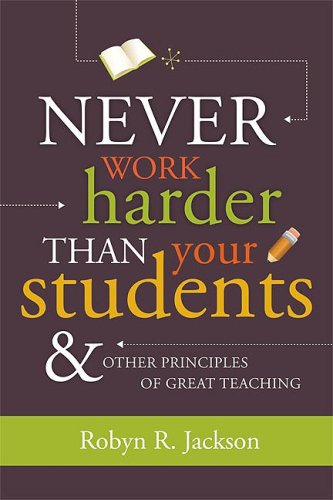We are using the book "Never Work Harder Than Your Students" to also infuse some culturally responsive and relevant teaching practices.
The chapter is titled: "Know where your students are going." This chapter almost seems to mimic the work done by Marzano in the Art and Science of teaching, as well as Wiggins and McTighe's work on Understanding by Design. Notice the connections.
Here are my takeaways from the chapter:
- Learning goals are more than what students do during a day, it's about what learning they should walk away with
- Teachers know objectives are important, but how to create objectives, how to determine whether or not student have achieved them remains for many to be very difficult
- Standards are your "final destination"
- Think about planning in this way:
- What do we, my state, and my community want kids to know by the end of this year/unit (learning goals)
- Develop assessments to determine mastery
- Develop scoring guides to measure proficiency and to utilize for feedback
- Develop lessons/activities that lead to proficiency
- Develop learning goals with the focus of whether the learning is a content or a process
- Challenge your students to exceed the standards and provide room for differentiation
- Understanding what the standard is allows you to:
- think through the goal
- determine if it's content or process, which leads to developing or finding appropriate lessons/activities
- think through steps to accomplish or acquire the content or skill
- Make learning goals concrete = how will you measure whether or not students have achieved this goal.
BRIEF ASIDE:
I do not like using the word "understand" in my learning goals. You cannot measure understanding. Replace the word understand with what you are asking kids to understand specifically and communicate how you will measure that understanding. From this I usually pull out my DOK wheel and begin to seek out the specific word, phrase, or skill we want kids to be able to answer. This way we know what mastery looks like, sounds like, or feels like in our classroom.
- How to make learning goals concrete:
- How will it be measured
- build criteria for mastery (rubric)
- break down into smaller chunks (steps to acquisition or success)
- Goals should represent the floor (minimum expectations) not the ceiling.
- Goals representing the floor allows for differentiation and extension opportunities
- Determine how to:
- know what it looks like when students have mastered the objective
- how to collect evidence of that mastery
- how to collect evidence over time
- Work with a team to determine exemplars and acceptable evidence of mastery
- The test is not the be-all-and-end-all BUT it is the "clearest articulation of the objective"
Great resources to support teachers found here: http://mindstepsinc.com/masterteacher/


No comments:
Post a Comment